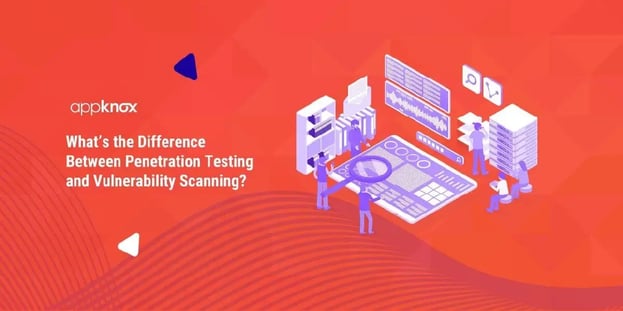
BLOG

BLOG
Is your network secure from outside attacks? What steps is your organization taking to keep its intellectual property and client data safe? Penetration and vulnerability scanning are two tools that can help identify gaps in your network security. In this article, we’ll look at how you can use these tools to evaluate your companies risk factors and whether penetration testing or vulnerability scanning is the right solution for you.
|
In terms of network security, risk is the likelihood of exploiting a system or network's vulnerabilities. An entity's size and the type of data stored on its systems play a big part in forming its risk profile.
For example, a large organization that designs highly-secretive intellectual property will have a different risk profile than a single location thrift store, but they both have risk. It’s also important to remember the stakeholders will have varying levels of risk tolerance.
Both of the methods we’re about to discuss will work to mitigate the potential risks to your network assets. The primary difference is the level of detail with which these vulnerabilities are sought and reported. Let’s begin with the more economical of the two, vulnerability scanning.

Vulnerability scanning is an essential tool to help evaluate problems with network settings and configurations. Organizations can purchase prepackaged solutions to fulfil a common compliance standard. The most common application of this type of service is to ensure adherence to the Payment Cards Industry, or PCI, compliance standards.
While these products are economical and meet minimum standards, vulnerability scans are completely passive. They don’t gain access to data on the target systems; the software merely ferrets out any conditions that are making a network asset an easy target. It’s also part of the hacking process, similar to old-school criminals “casing the joint” before a job, making it the first step in most penetration testing programs.
Good Read- Key Tests Every Mobile Vulnerability Scanner Must Perform
Because vulnerability scanning services use a “one-size-fits-all” approach, they do carry a lower price tag. Usually, these solutions will provide basic reports on open ports, sub-optimal security settings, out-of-date software, and some basic recommendations on improving security.

Penetration testing relies on vulnerability scans, but scanning for vulnerabilities is only one tactic a hacker might use to try to access your network assets. Penetration testers take finding weak points of your IT landscape to a whole other level. Penetration testing is active – meaning that real people are finding vulnerabilities and trying to exploit them.
Typically, these engagements are tailored to the client's needs and to meet specific objectives. Penetration testers create a simulated, real-world attack scenario rather than a simple scan.
Penetration testing can also include a social-engineering component, testing the human elements of your IT environment using techniques real-life hackers use to get users to divulge their credentials.
Read More- 12 Best Penetration Testing Tools for Security Assessment
Hiring a penetration tester takes a little extra effort than selecting a vulnerability scan, but it's well worth the extra effort. You'll want to get an idea of how much expertise you'll have to draw on.

Think of IT security in the same way you would think about building security. Vulnerability scanning tells attackers and system administrators what doors are ajar, but it's a surface-level analysis based on passive observations.
Penetration testing finds out where those doors can lead and applies unconventional techniques to gain access to your systems that go beyond simple scanning.
Vulnerability scans are best for organizations that need to certify that their systems are in compliance. While vulnerability scans provide reports with actionable items, they don't provide the same service level that penetration testing offers.
Read More- What is the Vulnerability Testing Process that Companies Should Follow
On the other hand, penetration tests are unique for each client, usually with little to no knowledge of the existing IT Infrastructure. This technique is the most robust, as it simulates real-world attacks.
If those attacks are successful, your pen tester works with your organization to develop the necessary patches, something you won't find with a standard vulnerability test.
Now that you understand the finer points of both vulnerability scans and penetration testing, it’s important to take the time to learn how to hire a freelance developer. Your solution will only be as good as the developer who implements it, and finding the right specialist is a lot easier when you understand the different kinds of services available to strengthen your network.
Hackers only need access to your network to steal your privacy. Every device that is connected to the internet is at risk for digital exploitation. As the problem grows, the number of breaches grows too.
Hackers now typically work in groups and will strategically time their requests to put as much pressure as possible on the target’s security protocols. These expansive breaches mean that our privacy is always up for grabs and if you’re not careful then you might expose yourself to the elements. Sadly, even with the damage it causes, most companies are still underprepared for a hacking attempt or data breach.
This means bad things for the company and anybody that deals with them.
The Internet is essentially a floating stream of exposed files and users that will infect any node without the appropriate levels of security. However, there are not many security protocols for your smart fridge that’s connected to your private company network.
Data breaches are systematic and strategic. In the earliest era of computing, hackers were quite rare. And, since many lacked computing power, there were few widespread attempts to unlock the data inside those now-archaic machines.
Must Read- Top 12 Most Powerful Vulnerability Assessment Scanning Tools in 2021
What’s more, the number of unmanaged devices is growing significantly as businesses struggle to keep up with the pace of technology. Unfortunately, those that lag are likely to be compromised and severely impact the fortunes of the company.
If you still have some questions, we've put together a list of common curiosities.
The CEH certification was one of the first, and arguably the most well known, certifications offered by the EC-Council. While the CEH is a valuable certification to have, the EC-Council recommends higher-level certifications for penetration testing.
When evaluating a pen-tester for your project, be on the lookout for any of the following certifications. These certifications provide assurance that your tester has learned the techniques necessary to produce an effective penetration testing program.
The Payment Card Industry has a list of approved scan vendors. You'll want to have qualified personnel administer the scan and any subsequent steps to remediate potential vulnerabilities.

